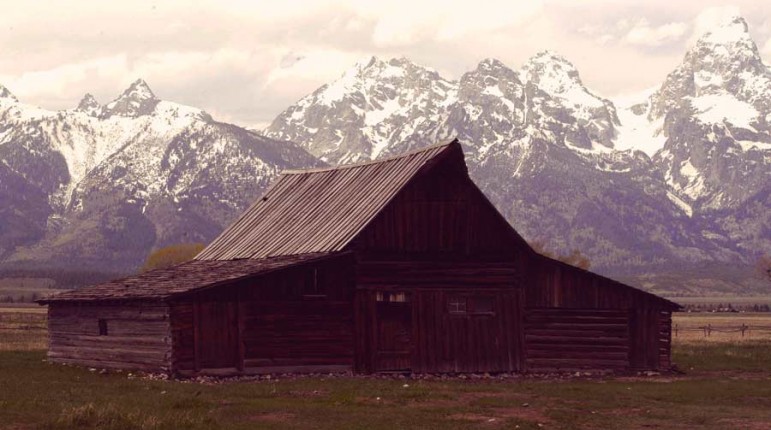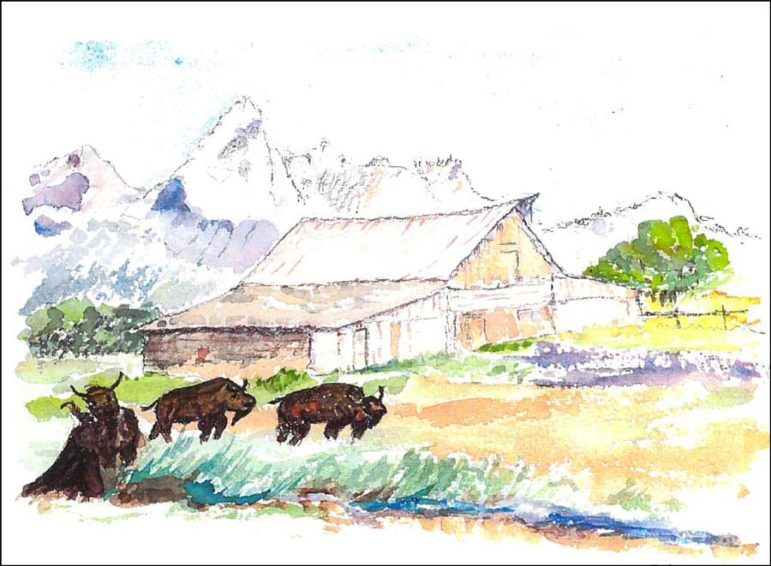
Volunteers have been instrumental in preserving the T.A. Moulton barn and other historic buildings in Grand Teton National Park.
During the 18th and 19th centuries, it was common for rural farmers and ranchers to volunteer their time at a community barn raising. The practice allowed for neighbors to spend a day or two building a vital structure that would help ensure someone’s livelihood for years to come.
For the past two decades, a group of volunteers have engaged in what amounts to a series of modern-day barn raisings—aimed not at building new structures, but preserving historic ones for future generations.
This is the 20th consecutive summer that a group known as the Michigan Volunteers have spent part of their summer working in Grand Teton National Park to preserve structures like the T.A. Moulton barn, as well as nearly 40 other buildings along Mormon Row, and at other spots in the park.
“Ed doesn’t like laying around on beaches,” said Judith Taylor of her husband, Ed Brown. Apparently, no one in their family likes laying around, as the Lansing, Mich. couple and others are spending the first two weeks of August shoring up buildings like the 102-year-old Moulton barn.
Taylor and Brown have led a core group of Michigan friends and family members who have worked since 1995 on dozens of historic preservation projects across Grand Teton.
This summer, the Michigan volunteers and others will be working on a range of projects along Mormon Row, which was added to the National Register of Historic Places in 1997.
Located near Antelope Flats Road, the Mormon Row historic district includes several picturesque barns and other buildings that are part of 27 homesteads established by members of the Church of Jesus Christ of Latter-day Saints, starting in the 1890s.
For many Grand Teton visitors, the Moulton barn is a brief photo opportunity or a tour bus stop on a checklist of park attractions. But for Taylor and the other volunteers, it’s an important piece of American history that’s worth more than a little hard work.
An unflagging devotion
A chance meeting in 1994 between Brown and Taylor and a member of the Chambers family—original homesteaders along Mormon Row—led to a return visit in 1995 that kicked off an unflagging devotion to preserving Grand Teton’s oldest and most vulnerable structures.
“We all enjoy working together as a team and having that collective experience in a beautiful place,” Taylor said. “But we also each do this for slightly different reasons.”
Born in the United Kingdom, Taylor first came to the U.S. in 1972. She married her American husband, and has stayed here ever since as a permanent resident.
Taylor works in the mental health field, where it can take a long time to see the results of her work. After two weeks toiling on an old building, she enjoys seeing the obvious progress she has accomplished, Taylor said.
Brown is a retired middle school teacher who likes working with his hands, and regularly volunteers with friends in Michigan on projects for Habitat for Humanity.
Taylor’s late mother, Margaret, enjoyed the sense of history from working on old buildings in Grand Teton, as well as sketching and painting the barns along Mormon Row and chatting with park visitors.

A watercolor by Margaret Taylor depicts bison near the T.A. Moulton Barn in Grand Teton National Park.
Taylor said her mother helped with the buildings well into her 80s and 90s. At the other end of the spectrum, Taylor’s daughter, Elizabeth, was 9 when she first tagged along on a Grand Teton work trip.
Brown and Taylor have also volunteered on restoration projects in other parks, including what is now a bookstore at Norris in Yellowstone National Park.
The work is not glamorous, but it’s important, said Betsy Engle, architectural historian for Grand Teton.
“We would not be able to complete the work we do without the support of dedicated volunteers like the folks from Michigan, who come back year after year,” Engle said.
“They have worked throughout the park on properties that may not be here today without their commitment,” she said.
Engle said volunteers do tasks like roofing, staining and cleaning historic structures, along with other “critical preservation work that the park would not otherwise be able to complete, so for that, we are sincerely thankful.”
Rising priority
Taylor said she is pleased to see historic preservation becoming a more important priority for the National Park Service over the past two decades.
But she would still like to see more signs, displays and other interpretive support for Mormon Row and similar places in the nation’s parks.
Park officials say part of the work being done this summer will address that concern, including construction of a half-mile interpretive trail that will run parallel to Mormon Row Road, from the Antelope Flats Road to the Andy Chambers homestead cabin.
Other work includes a new parking lot and vault toilet near the Moulton barn, as well as additional preservation efforts led by Harrison Goodall, an architectural conservator who specializes in barns and log buildings. Support for much of the work is provided by the Grand Teton National Park Foundation and the Western Center for Historic Preservation.
Kim Mills, spokeswoman for the Grand Teton National Park Foundation, said it is obvious that the Michigan volunteers “really love human history in the valley and want to see it preserved.”
“They’ve worked on the Lucas Fabian property, Bar BC Dude Ranch, Murie Ranch, White Grass Dude Ranch, Hunter Hereford Ranch and Mormon Row, to name a few,” Mills said. “If it weren’t for the Michigan volunteers, some of Grand Teton’s iconic structures would be in ruins by now.”
Taylor said she expects to continue her Grand Teton efforts.
“This keeps us young and keeps us active. I don’t know what we would have done with our vacations if not for this,” she said. “I’m just pleased we can play a role in helping people understand why this is such an important part of American heritage.”
Contact Ruffin Prevost at 307-213-9818 or ruffin@yellowstonegate.com.
